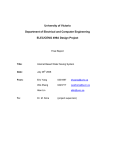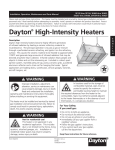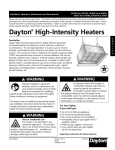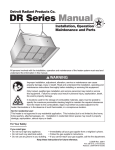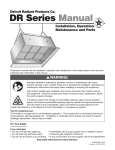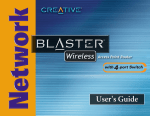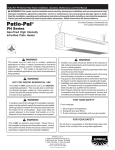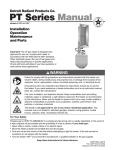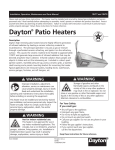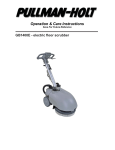Download Detroit Radiant IR Series Installer`s Guide - H
Transcript
IR Series This heater must be installed and serviced by trained gas installation and service personnel only! Read and understand these instructions thoroughly before attempting to assemble, install, operate or maintain the product described. Protect yourself and others by observing all safety information. Failure to comply with instructions and those on the heater could result in personal injury, death, fire, asphyxiation and/or property damage! Retain instructions for future reference. Detroit Radiant Products Company - IR Series - WARNING WARNING Improper installation, alteration, service or maintenance can cause property damage, injury or death. Read the installation, operating and maintenance manual thoroughly before installing or servicing this equipment. This heater must be installed and serviced by trained gas installation and service personnel only. Read and understand these instructions thoroughly before attempting to install, operate or service this heater. Failure to comply could result in personal injury, asphyxiation, death, fire, and/or property damage. WARNING WARNING - NOT FOR RESIDENTIAL USE This heater is NOT approved for use in any residential application. This includes (but is not limited to) attached garages, solariums, living quarters, etc. Consult the local fire marshal and/or insurance provider if unsure of your application. This is NOT an explosion-proof heater. Where there is the possibility of exposure to flammable vapors, consult the local fire marshal, the fire insurance carrier and other authorities for approval of the proposed installation. FOR YOUR SAFETY FOR YOUR SAFETY Do not store or use gasoline or other flammable vapors and liquids in the vincinity of this or any other appliances. What to do if you smell gas: • • • • Form # LIOIR-1M-11/03 (HH) Do not try to light any appliance. Do not touch any electrical switch or use any phones in your building. Immediately call your gas supplier from a neighbor’s phone. Follow the gas supplier’s instructions. If you cannot reach your gas supplier, call the fire department. © DETROIT RADIANT PRODUCTS COMPANY ENGLISH Installation, Operation, Maintenance and Parts Manual IR Series Installation, Operation, Maintenance and Parts Manual Detroit Radiant Products Company CAUTION! The following information should be reviewed before installing this heater: • • • • Check the AGA rating label on the heater to verify • model number. Check and maintain the attached minimum clearance to combustibles label and the proper gas to be used. Check all labels on the heater to verify proper mounting. • The installation of this heater must conform with local building codes or, in the absence of local codes, with the National Fuel Gas Code, ANSI Z223.1-1999 (NFPA 54-current edition). • The installation of this heater in public garages must conform with the Standard for Parking Structures, ANSI / NFPA 88A-current edition: or the Standard for Repair Garages, ANSI / NFPA • 88B-current edition, and must be at least 8 ft. above the floor while maintaining all clearances to combustibles. • The installation of this heater in aircraft hangars must conform to the Standard for Aircraft Hangars, ANSI / NFPA 409-current edition. The heater must be installed at least 10 ft. above the • upper wing surfaces and engine enclosures of the highest aircraft which might be stored in the hangar. In areas adjoining the aircraft storage area, the heaters must be installed at least 8 ft. above the floor. The heaters must be located in • areas where they will not be subject to contact by aircraft, cranes, moveable scaffolding or other objects. 2 If an external electrical source is utilized, the heater must be electrically grounded in accordance with the National Electrical Code, ANSI / NFPA70-current edition. Under no circumstance is either the gas supply line or the electrical supply line to the heater to provide any assistance in the suspension of the heater. The weight of the heater must be entirely suspended from a permanent part of the building structure having adequate load characteristics. Neither the gas supply line, electrical supply line nor sprinkler heads shall be located in or near the path or the flue products from the heater. This heater cannot be used in a building with an uninsulated roof or condensation problems could result. Where this heater is used, natural or mechanical means shall be provided to supply and exhaust at least 4.0(Nat.) or 4.5(LP) C.F.M. per 1000 BTU/ H input of the heater’s rated input. Signs should be posted in storage areas to specify maximum stacking height allowed in order to maintain clearance to combustibles. Clearance safety limit plaques (PLQ), available from Detroit Radiant Products are recommended for this purpose. IR Series Installation, Operation, Maintenance and Parts Manual IR Series Heaters WARNING! WARNING! Failure to comply with the stated clearance to combustibles could result in personal injury, death and/or property damage. This heater should be installed so that the minimum clearance to vehicles, as marked on the heater, will be maintained. If vehicle lifts are present, ensure that these clearances will be maintained from the highest raised vehicle. CLEARANCES TO COMBUSTIBLES (IN.) Model No. Sides Back Top Below IR 30 (S) IR 30 IR 60 IR 90 30 30 32 48 18 18 18 30 28 28 40 42 72 72 72* 98 * This clearance is 80 in. when the heater is fitted with a parabolic reflector. Figure 1.1 CLEARANCE-TO-COMBUSTIBLES CHART NOTE: If the heater is mounted beneath a non-combustible surface a 24 in. minimum clearance must be maintained from the top of the heater to prevent overheating the controls. Figure 1.2 CLEARANCE-TO-COMBUSTIBLES DIAGRAM 3 IR Series Installation, Operation, Maintenance and Parts Manual Detroit Radiant Products Company 1.1 DESIGN 1.2 LAYOUT When positioning heater, keep in mind the clearance to combustible materials, lights, sprinkler heads, overhead doors, storage areas with stacked materials, gas and electrical lines, parked vehicles, cranes, etc. Refer to Figure 1.1 on page 3 for minimum clearance to verify that a safe installation condition exists. Perimeter mounting of these infrared heaters provides for the most efficient installation. In Figure 1.5, the heaters are mounted around the perimeter of the space to be heated. Refer to the Installation Chart for the recommended distances on the models being installed. Buildings that require the rows of heaters to be farther apart than the recommended distance in the Installation Chart may need additional heaters placed in the center of the space as in Figure 1-5. In locations used for the storage of combustible materials, signs shall be posted to specify the maximum permissible stacking height to maintain required clearances from the heater to the combustibles. Typical exhauster, air intake louver and thermostat location is also shown on the sample buildings in Figure 1.5. IR SERIES SPOT HEATER LOCATION CHART “B” DIM. APPROX. DISTANCE CENTERS FOR APPROX. BEHIND FULL MAN OR COVERAGE DIMENSIONS APPROX. RECOMMENDED MOUNTING HEIGHT MODEL (“A” DIM.) WORK (SPOT & AREA) TYPE AREA OF AREA SQ. FT. & COVERED COVERED 10’ 12’ 14’ 16’ 18’ 20’ 22’ 24’ 26’ 28’ 30’ STATION HTG. ONLY (SURROUNDINGS) INPUT 9’ 4’ 10’ COLD/DRAFTY 10’ X 10’ 100 IR-30 AVERAGE 12’ X 12’ 144 10’ 12’ 5’ 12’ 30,000 14’ X 14’ 196 12’ 14’ 6’ 14’ BTU/H PROTECTED/INSUL. COLD/DRAFTY 16’ X 16’ 256 12 14’ 6’ 16’ IR-60 324 14’ 16’ 7’ 18’ AVERAGE 18’ X 18’ 60,000 16’ 18’ 8’ 20’ 20’ X 20’ 400 BTU/H PROTECTED/INSUL. COLD/DRAFTY 20’ X 20’ 400 16’ 18’ 20’ IR-90 18’ 20’ AVERAGE 24’ X 24’ 576 24’ 90,000 28’ X 28’ 784 20’ 26’ BTU/H PROTECTED/INSUL. ’ 32’ 35’ Figure 1.3 4 IR Series Installation, Operation, Maintenance and Parts Manual IR Series Heaters HEATER INSTALLATION CHART Model No. IR 30(S) Mounting Heights (Dimension A) 30 ° Angle 30 ° Angle Standard Parabolic Reflector Reflector [ft] [ft] 12-14 12-15 Distance Between Heaters (Dimension B) [ft] 8-30 Distance Between Heater Rows (Dimension C) [ft] 10-70 Distance Between Heater and Wall [ft] 6 IR 130 12-14 12-15 8-30 10-70 6 IR 60 14-16 18-21 15-43 15-90 12 IR 90 16-18 21-25 20-55 20-110 12 Figure 1.4 NOTE: The chart above is provided as a guideline only. Actual conditions may dictate variation from the data shown. Figure 1.5 NOTE: Dimensions A, B and C refer to figure 1.4 5 IR Series Installation, Operation, Maintenance and Parts Manual Detroit Radiant Products Company • 2.1 HEATER MOUNTING • Figures 2.1 and 2.2 illustrate the more commonly used methods for heater mounting. Figure 2.1 shows the fastest and most economical method. Some local codes or application conditions, such as drafts that could cause units to swing, stipulate that if flexible gas connectors are used then the heaters must be rigidly mounted (Figure 2.2) Heater must be level from side to side (see Figure 1.2 on pg. 3). The units must be mounted at a 20° to 35° angle from horizontal, so the controls (or manifold end) are located at the lower end (Figure 2.3-2.5). Gas and electrical lines must not be located above the path of exhaust. Do not install gas piping or electrical wiring above flue discharge area. Figure 2.3 BURNER ASSEMBLY RELATION TO GROUND LEVEL Proper Incorrect Optional 325-3 regulator required where gas supply pressure exceeds 14” W.C.P Figure 2.1 TYPICAL HEATER MOUNTING Figure 2.4 BURNER ASSEMBLY RELATION TO GROUND LEVEL Figure 2.2 RIGID HEATER MOUNTING Figure 2.5 BURNER ASSEMBLY RELATION TO GROUND LEVEL 6 IR Series Installation, Operation, Maintenance and Parts Manual IR Series Heaters 3.1 GAS SUPPLY MANIFOLD PRESSURE CHART Minimum Required Inlet Pressure Manifold (WCP) Pressure (WCP) CAUTION! CORRECT INLET PRESSURES ARE VITAL FOR EFFICIENT OPERATION OF HEATER. REFER TO AGA/CGA RATING PLATE AND, IF NECESSARY, CONSULT GAS COMPANY. Maximum Inlet Pressure (WCP) Natural Gas 6.0 in. 7.0 in. 14.0 in. Liquified Petroleum Gas 10.0 in. 11.0 in. 14.0 in. Figure 3.1 If all or a portion of the gas supply line consists of used pipe, it must be cleaned and then inspected to determine its equivalency to new pipe. Test all main supply lines according to local codes. (Isolate heater gas valve and supplied gas cock during test.) Use only a pipe joint compound that is resistant to liquified petroleum gases. • Allowance for Expansion Allowances must be made for the system to expand. The use of a stainless steel, flexible gas connector is recommended. If, however, local codes require rigid piping to the heater, a swing joint can be used. Excessive torque on manifold may misalign orifice(s). Always use two wrenches when tightening mating pipe connections. WARNING! Never use a match or any other flame to test for gas leaks. Use a soap and water solution to check for leaks. • Gas Line Connection a. The gas outlet shall be in the same room as the appliance and the connector must not be concealed within or run through any wall, floor or partition. b. The connector shall be of adequate length. c. The final assembly shall be tested for leaks. CAUTION: Matches, candles, open flame or other sources of ignition shall not be used for this purpose. Leak test solutions may cause corrosion-water rinse after test. d. Contact with foreign objects or substances should be avoided. e. The connector should not be kinked, twisted or torqued. f. Connectors are for use only on piping systems having fuel gas pressures not in excess of ½ pound per square inch or 14.0 in. W.C.P. g. Bending, flexing and vibration to the gas connections should be avoided. If any portion of the gas supply line is located in an area that could cause an abnormal amount of condensate to occur in the pipe, a sediment trap should be installed. NOTE: For high pressure gas above 14 in. W.C.P. (Water Column), a high pressure regulator and gas cock must be used. If compressed air is used to detect leaks in the gas supply line, disconnect and cap shutoff cock to avoid damage to regulator and gas valve. A sediment trap in the gas line will decrease the possibility of any loose scale or dirt in the supply line entering the heater’s control system and causing a malfunction. Provide a 1/8 in. (3.2mm) NPT, plugged tapping accessible for test gauge connection immediately up stream of gas connection to heater. The gas supply line must be of sufficient size to provide the required capacity and inlet pressure to the heater (consult gas company) as follows: CAUTION! CONNECTOR NUTS MUST NOT BE CONNECTED DIRECTLY TO PIPE THREADS. THIS CONNECTOR MUST BE INSTALLED WITH ADAPTORS PROVIDED. DO NOT REUSE. NOTE: Manifold pressure should be checked at the tap on the gas valve. Readings will be above atmospheric pressure (during operation). 7 IR Series Installation, Operation, Maintenance and Parts Manual Detroit Radiant Products Company 4.1 ELECTRICAL For wiring of controls on the unit see the wiring diagram included on the provided insert. WARNING! The unit, when installed, must be electrically grounded in accordance with the most current national electrical code, ANSI/NFPA-70, when an external source is utilized. It is recommended that the thermostat be installed on the hot side of a fused supply line and have a sufficient ampere capacity rating for the heater(s) it will control. Control systems are energized by either 120 VAC, 24 VAC or millivolt energy. The 120 VAC systems can be used directly from a 120 VAC line. On 24 VAC systems, transformers must be used to supply power of sufficient VA rating for single or multiple connected installations. The ventilation system may be controlled separately from the heating system by use of a humidistat that closes on a rise in humidity. The humidistat control should be installed at roof level. For summer ventilation, a simple on/off switch can be installed at the occupant level. Millivolt systems require NO external power, as energy needed to operate the valve is developed by the power-pile generator. Do not use multiple con- OPERATION nections, as one thermostat may only control one heater. Upon satisfactory completion of the electrical supply and the purging of the gas supply line to the heater(s), Important: Proper grounding and polarity are follow the “Lighting Instructions” on the heater’s rating essential for heaters with spark ignition controls. If label to put heater into operation. the system is not grounded to a positive source, it cannot determine the presence of a flame and will Note: Do not attempt to ignite the pilot by hand on lockout and shut off. heaters equipped with automatic pilot igniters. Figure 4.1 TYPICAL FIELD WIRING 8 Installation, Operation, Maintenance and Parts Manual IR Series IR Series Heaters NFS-2/PFS-2 (24V) 24 V SCHEMATIC Direct Spark Ignition VA Draw : 12 Amps : .48 Figure 4.3 NFS-2/PFS-2 (120V) 120 V SCHEMATIC Direct Spark Ignition VA Draw : 12 Amps : .10 (potted circuit board) Figure 4.4 9 IR Series Installation, Operation, Maintenance and Parts Manual Detroit Radiant Products Company 5.1 Ventilation Ventilation of upper levels of the space to be heated is required to supply combustion air to the heaters in order to sufficiently dilute the products of combustion. This also prevents excessive humidity buildup. With heaters mounted overhead and a properly designed ventilation system, products of combustion and excessive drafts will never be present at occupancy levels. For proper ventilation, a positive air displacement of 4.0 CFM per 1000 BTU/H of natural gas consumed must be provided. If propane is used, a positive air displacement of 4.5 CFM per 1000 BTU/H of propane gas consumed must be provided. Many large industrial buildings have sufficient air movement to satisfy these dilution requirements. However, in tightly constructed buildings where insufficient air movement exists, induced air displacement is required. This air displacement may be accomplished by either gravity or mechanical means. Provisions must be made to provide sufficient fresh air intake area and exhaust air outlet area. This is essential to provide a balanced system to avoid negative building pressure which cause excessive infiltration and unfavorable drafts thereby affecting efficient combustion of infrared heaters. Mechanical exhausters are preferred and typically mounted at high points of the building on areas of the roof where stagnant air can accumulate under the deck. For a flat roof, considerations of prevailing winds, high and low pressure areas, and distribution of air movement must be taken into consideration when locating exhausters. Best air distribution is accomplished by using a number of small exhausters versus one large exhauster. Approximately one square inch of net free inlet area per 1000 BTU/H is adequate for combustion air supply. Inlet opening in the building should be well distributed high in the sidewalls and should direct incoming air upward to dilute products of combustion while preventing drafts at lower levels. Inlets are typically 1 to 3 sq. ft. Local codes may require that mechanical exhaust systems be interlocked with heaters to enable both to function simultaneously (Figure 4.1 on pg.8). Other codes may allow control of exhausters with a ceiling mounted humidistat. Exhausters then operate when relative humidity rises above humidistat setting. Since the products of combustion increase the relative humidity level of the space, this is a feasible method of controlling exhausters. Selection of a humidistat setting will vary with different conditions and areas of the country. 10 IR Series Installation, Operation, Maintenance and Parts Manual IR Series Heaters • Main Burner 1. Use an air hose to blow any accumulated dust and/or dirt off the heater. Air hose pressure should not exceed 30 psig. 2. Pass the air hose over the entire exposed area of the ceramic. A distance of 2-4’ from the unit is recommended. 3. Place the air hose outlet into each venturi tube and allow the air to flow for approximately one minute. 4. See troubleshooting chart (pg. 12) if there are any signs of burner malfunction. Replace if necessary. 6.1 MAINTENANCE WARNING! Disconnect all power sources related to the installation before servicing any component. WARNING! Use protective glasses when cleaning the heater. If the control assembly is not completely disconnected from the manifold, the high air pressure will cause the controls to become defective. It is recommended that the following become a standard yearly procedure to obtain maximum operating efficiency and trouble free operation. During long periods of non-usage, remove or cover heater with a polyethylene bag and shut off gas supply. If further service to the heater is desired, contact your representative or the factory. • Pilot Burner 1. Remove pilot access door. 2. Use an air hose and blow the pilot burner free of dust. 3. Remove pilot orifice and clean with a wire of less than 0.012 in. diameter. 4. Clean pilot burner’s primary air inlet passage. 5. Replace orifice and then pilot access door. 6.2 HEATER ASSEMBLY COMPONENTS For complete information on IR Series replacement parts, consult the Universal-Ray IR Series Parts Price List. This list includes information on valves, igniters, circuit boards, etc. for all gas controls ever utilized on the IR Series. Note: Replacement burners are called "rayheads" with rod inserts (Part # DR-RH and DRROD). Note: Ceramic grids are not sold separately, order DR-RH. IR 30(S) IR 30 IR 60 IR 130 D R S EIR R IESERIES S U N V E NUNVENTED T E D G A S-F IR EGAS-FIRED D IN F R A -R E DINFRA-RED H E A T E R A S SHEATER E M B L Y ASSEMBLY Figure 6-1 11 1 DR-RH 2 DR-RH 3 DR-RH 4 DR-RH 7.1 TROUBLESHOOTING SYMPTOM Burning of gas-air mixture inside plenum (flashback). Delayed ignition. POSSIBLE CAUSE 1. 2. 3. 4. 5. 1. 2. 3. 4. 5. 1. 2. 3. 4. Heater mounted at incorrect angle. Excessive drafts. Gas leaking at orifice, spud, pilot tube. Separation of ceramic grids. Ceramic grids cracked. Electrode out of specification. Low gas pressure. Partially blocked orifice. Improper orifice size. Incorrect gas. Dirty or plugged rayhead ceramics. Partially blocked orifice. Low inlet gas pressure. Low manifold gas pressure. 5. High manifold pressure. Low ceramic surface temperature, excessive rollout or soot on rods. 6. Foreign matter in venturi tube. 7. Misaligned manifold from excessive torque applied on pipe during installation. 8. Excessive dark spots on rayhead. 9. Gas supply piping too small. 10. Incorrect gas. 1. Heater not mounted correctly. Control system overheating. 2. Heater mounted too close to ceiling. 1. Loose pipe connection. Gas odor. 1. Heater located in drafty area. 2. Low gas pressure. Heater cycles repeatedly. 3. Thermostat located in drafty area. 4. Defective flame detector. 1. Lack of 120V or 24V incoming voltage. 2. Open high voltage wire. 3. Improper electrode gap. 4. Loose or open wire connection. 5. Poor or no equipment ground. No spark; no ignition. 6. Unit in "safety lockout" mode. 7. Defective "Gaslighter" control. 8. Defective mercury sensor. 9. Defective pilot ignition transformer. 1. Poor or no equipment ground. Heater lights, and "locks out" after approximately 10 seconds. Spark is present. No main gas operation. Unit "locks out". Heater will not shut off. 2. 3. 4. 5. Polarity is reversed. Low gas pressure. Electrode not sensing. Heater mounted at incorrect angle. 1. Gas valve in "OFF" position. 2. Defective main valve solenoid. 3. 1. 2. 3. Defective "Gaslighter" control. Defective thermostat or wiring. Gas valve stuck open. High gas pressure. CORRECTIVE ACTION 1. 2. 3. 4. 5. 1. 2. 3. 4. 5. 1. 2. 3. 4. Mounting angle 20º-35º from horizontal. Relocate or shield from draft. Check with leak detector solution. Replace rayhead. Replace rayhead. See Ignition System insert. See Section 3.1, Gas Supply. Clean or replace. Consult dealer. See unit nameplace. See perodic maintenance instructions. Remove and clean. See Section 3.1, Gas Supply. Adjust main valve regulator for 6" W. C.P. natural gas, 10" W. C.P. propane. 5. Adjust main valve regulator for 6" W. C.P. natural gas, 10" W. C.P. propane. 6. See periodic maintenance instructions. 7. Replace manifold. 8. See periodic maintenance instructions. 9. Increase inlet pressure or replace undersize piping. 10. See unit nameplate. 1. Mounting angle 20º-35º from horizontal. 2. Observe clearance to combustibles safety chart located on heater reflector. 1. Check all connections with leakdetector solution, tighten as necessary. 1. Relocate or shield from draft. 2. See Section 3.1, Gas Supply for propane. 3. Relocate thermostat. 4. Replace. 1. Clean or adjust pilot. 2. Isolate and ohm for resistance, replace if 0. 3. See Ignition System insert. 4. Check all wires, tighten or replace. 5. Trace ground wire for complete circuit back to equipment ground from control. 6. Interrupt power source, repeat trial for ignition. 7. Replace. 8. With element cold, isolate control. Ohm for resistance between 3 & 4. replace if 0. 9. Replace. 1. Check all connections, provide positive earth ground. 2. 120V to black, neutral to white. 3. See Section 3.1, Gas Supply. 4. Relocate or replace if defective. 5. Mounting angle 20º-35º from horizontal. 1. Turn to "ON" position. 2. Isolate and check for resistance. replace if 0. 3. Replace. 1. Replace or repair. 2. Replace. 3. See Section 3.1, Gas Supply.












